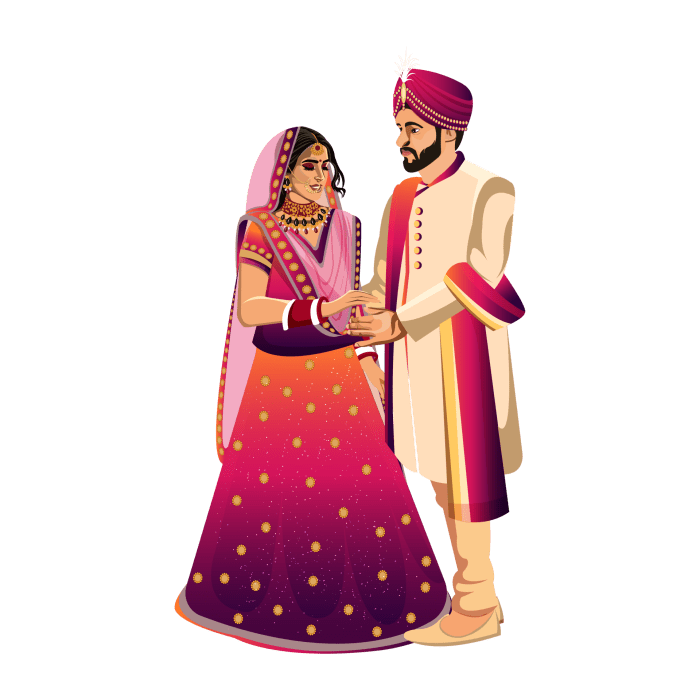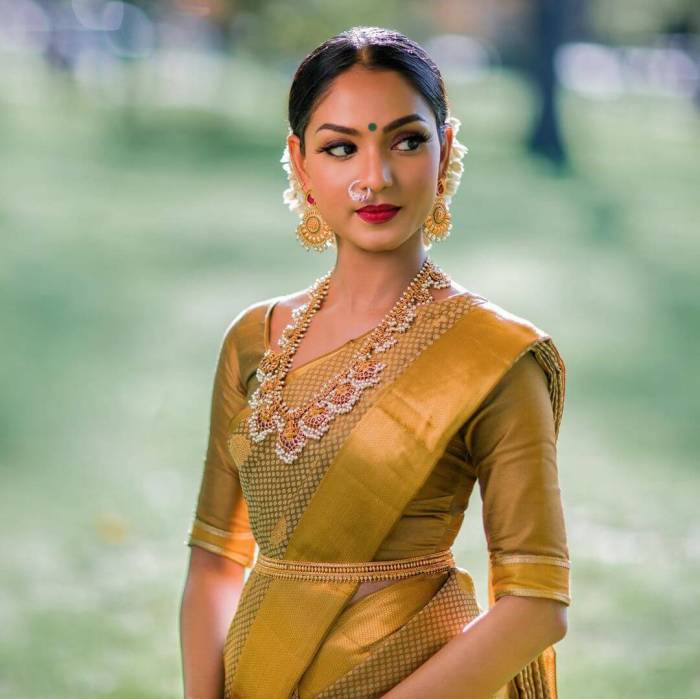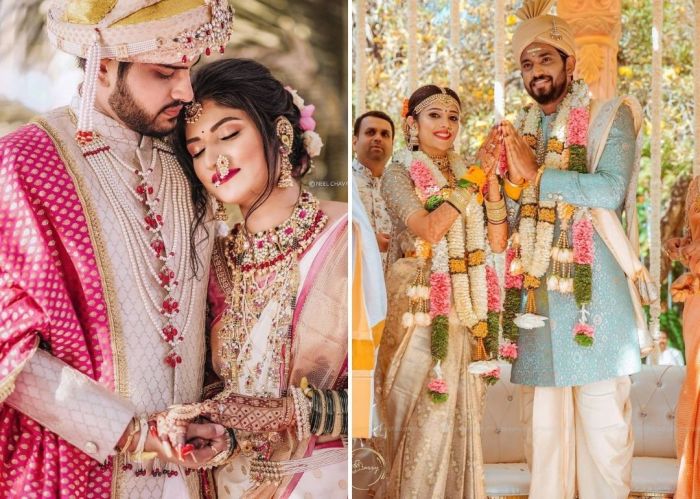Types of South Indian Wedding Dresses

Source: vecteezy.com
South Indian weddings are a vibrant spectacle of culture and tradition, and the bridal attire plays a central role in this celebration. The diversity of South India is reflected in the varied styles of sarees and the accompanying jewelry, makeup, and hairstyles. This section explores the different types of South Indian wedding dresses, highlighting regional variations and the cultural significance of specific choices.
South Indian Saree Styles

Source: shaadiwish.com
The saree, a staple of Indian attire, takes center stage in South Indian weddings. Several styles are prevalent, each with its own unique characteristics and regional association. The Kanjeevaram silk saree, originating from Kanchipuram in Tamil Nadu, is particularly renowned for its rich, lustrous texture and intricate gold zari work. Banarasi sarees, though originating from Varanasi in North India, are also popular choices, prized for their delicate brocades and opulent designs.
Other popular choices include the Mysore silk saree from Karnataka, known for its softness and vibrant colors, and the Patola saree, a double ikat saree with complex geometric patterns, often seen in Gujarat but also adopted in South India.
South Indian wedding attire is incredibly diverse, ranging from vibrant silks to elegant kanjeevarams. For guests attending such a vibrant celebration, a stylish and comfortable option could be a flowing maxi dress, perhaps finding inspiration from the many beautiful options available at maxi wedding dress guest websites. Returning to the South Indian context, the overall aesthetic is often richly detailed and colourful, providing a beautiful backdrop for any guest’s outfit choice.
Regional Variations in Bridal Attire

Source: shaadiwish.com
Bridal attire varies significantly across the different states of South India. In Tamil Nadu, the Kanjeevaram silk saree reigns supreme, often in bright, auspicious colors like red, maroon, or gold. Kerala brides often opt for Kasavu sarees, characterized by their cream or off-white color and gold zari borders. Karnataka brides might choose Mysore silk sarees or other richly embellished sarees in vibrant hues.
Andhra Pradesh and Telangana brides favor sarees with intricate embroidery and embellishments, often in rich colors like red, orange, or green.
Significance of Colors and Fabrics
Color and fabric choices in South Indian bridal attire hold deep cultural significance. Red, for instance, is widely considered auspicious, symbolizing prosperity and good fortune. Gold, another prominent color, represents wealth and divinity. The choice of fabric also reflects the bride’s family’s social standing and the occasion’s grandeur. Silk, particularly Kanjeevaram silk, is highly valued for its luxurious texture and enduring quality.
Comparison of South Indian Bridal Sarees
| Saree Type | Origin | Key Characteristics | Typical Colors |
|---|---|---|---|
| Kanjeevaram | Tamil Nadu | Heavy silk, gold zari work, intricate designs | Red, maroon, gold, green |
| Banarasi | Varanasi (North India, but popular in South) | Fine silk, delicate brocades, intricate motifs | Red, gold, cream, pastel shades |
| Mysore Silk | Karnataka | Soft silk, vibrant colors, simple yet elegant designs | Various bright colors, often with gold borders |
| Kasavu | Kerala | Cream or off-white silk, gold zari borders, simple elegance | Off-white, cream, beige |
Jewelry and Accessories
South Indian bridal jewelry is as elaborate and diverse as the sarees themselves. It’s not merely adornment; it carries deep cultural and symbolic meaning, passed down through generations.
Traditional South Indian Bridal Jewelry
A typical South Indian bridal jewelry set includes a variety of pieces, often crafted in gold and adorned with precious stones. This includes necklaces (like the long, layered haram and the choker-style kasu mala), earrings (jhumkas, studs, and long, dangling pieces), bangles (often gold and studded with gemstones), and anklets (payal). The nose ring (nath) and maang tikka (forehead ornament) are also essential elements.
Cultural Significance of Jewelry Pieces
Temple jewelry, inspired by the architecture and ornamentation of South Indian temples, holds particular significance. Its intricate designs and use of precious stones reflect the richness and artistry of the region’s heritage. Each piece often carries symbolic meaning, reflecting prosperity, fertility, or protection.
Materials Used in South Indian Bridal Jewelry
Gold is the predominant metal used in South Indian bridal jewelry, often 22 or 24 karat. Diamonds, emeralds, rubies, and other precious stones are frequently incorporated to enhance the jewelry’s beauty and symbolic value. The craftsmanship involved in creating these pieces is often passed down through generations of skilled artisans.
A Typical South Indian Bridal Jewelry Set
Imagine a bride adorned with a cascading haram necklace, intricately crafted with gold and studded with emeralds and rubies. Matching jhumkas dangle from her ears, their delicate movements catching the light. Her wrists are adorned with numerous gold bangles, their rhythmic clinking adding to the festive atmosphere. A maang tikka rests gracefully on her forehead, completing the ensemble.
A delicate nath adds a final touch of elegance.
Makeup and Hairstyles
The makeup and hairstyles of a South Indian bride are as carefully considered as her attire and jewelry. These elements contribute significantly to her overall look, reflecting traditional beauty standards and cultural values.
Traditional South Indian Bridal Makeup Styles
Traditional South Indian bridal makeup emphasizes a natural, radiant look, enhancing the bride’s features rather than masking them. A focus is placed on flawless skin, achieved through a combination of skincare and makeup techniques. The eyes are typically highlighted with kohl and kajal, while the lips are adorned with a rich, red lipstick. Blush is used sparingly to add a touch of color to the cheeks.
Use of Specific Cosmetics
Traditional cosmetics, such as sandalwood paste, turmeric powder, and hibiscus flower extracts, are often incorporated into the bridal makeup routine. These ingredients not only enhance the bride’s appearance but also possess skincare benefits and cultural significance. Sandalwood paste, for example, is believed to soothe the skin and provide a cooling effect.
Traditional South Indian Bridal Hairstyles
Traditional South Indian bridal hairstyles often involve intricate braiding and bun arrangements, sometimes adorned with flowers and jewelry. The specific style may vary depending on the region and family traditions. Elaborate braids, adorned with jasmine flowers, are a common feature, symbolizing purity and grace.
Step-by-Step Guide for Applying Traditional South Indian Bridal Makeup
- Cleanse and moisturize the skin.
- Apply a thin layer of foundation for an even complexion.
- Use concealer to cover blemishes or dark circles.
- Apply kajal and kohl to define the eyes.
- Apply a subtle eyeshadow in neutral tones.
- Apply blush to the cheeks.
- Apply lipstick in a rich red shade.
Modern Interpretations
While tradition remains deeply valued, modern South Indian bridal fashion shows a fascinating blend of heritage and contemporary styles. Designers are creatively incorporating modern elements into traditional attire, resulting in unique and stylish interpretations.
Traditional vs. Contemporary South Indian Wedding Dresses
Traditional South Indian wedding dresses are typically characterized by their use of rich fabrics, intricate embroidery, and vibrant colors. Contemporary interpretations often retain these elements but incorporate modern silhouettes, cuts, and embellishments. For example, a traditional Kanjeevaram saree might be paired with a contemporary blouse design, creating a fresh and modern look.
Trends Influencing Modern South Indian Bridal Fashion
Modern trends in South Indian bridal fashion are influenced by global fashion trends, celebrity styles, and the evolving preferences of brides. This includes incorporating pastel shades alongside traditional colors, experimenting with different necklines and sleeve styles for blouses, and adding contemporary embellishments like sequins or beads.
Incorporating Modern Elements into Traditional Attire
Designers are innovatively incorporating modern elements into traditional South Indian wedding attire. This might involve using modern techniques like laser cutting or 3D printing to create intricate embellishments or incorporating unconventional fabrics alongside traditional silks. The result is a fusion of heritage and modernity, creating unique and stylish looks.
Evolution of South Indian Bridal Fashion
Over time, South Indian bridal fashion has evolved, reflecting changing social norms and global influences. While traditional elements remain central, there has been a gradual shift towards more contemporary styles and a greater emphasis on individual expression. This evolution is a testament to the enduring appeal of traditional attire while embracing modern sensibilities.
Cultural Significance and Symbolism
Every element of a South Indian bride’s attire carries deep cultural and symbolic meaning, reflecting the region’s rich heritage and traditions. Understanding this symbolism enhances the appreciation of the artistry and cultural significance of the wedding attire.
Cultural Significance of Elements in a South Indian Wedding Dress
The saree, jewelry, makeup, and hairstyle all contribute to the overall symbolism of the bride’s attire. The saree’s color and fabric represent prosperity and social status, while the jewelry symbolizes wealth, fertility, and protection. The makeup and hairstyle reflect traditional beauty standards and cultural values.
Symbolism of Colors, Fabrics, and Jewelry
Red symbolizes prosperity and good fortune; gold represents wealth and divinity; silk signifies luxury and social standing. Specific jewelry pieces, like the mangalsutra (sacred wedding necklace), carry symbolic meaning related to marital bonds and blessings.
Role of Wedding Attire in Preserving Cultural Heritage
The meticulous attention to detail in creating and wearing traditional South Indian wedding attire plays a vital role in preserving cultural heritage. It transmits traditions and values across generations, ensuring the continuity of cultural practices and artistic skills.
Symbolic Meaning of Key Aspects of a South Indian Wedding Dress
- Saree: Represents prosperity, social status, and the bride’s family lineage.
- Gold Jewelry: Symbolizes wealth, prosperity, and divine blessings.
- Red Color: Represents auspiciousness, good fortune, and fertility.
- Mangalsutra: Symbolizes the sacred marital bond and blessings for a happy married life.
- Intricate Hairstyle: Represents grace, femininity, and adherence to tradition.
The Making of a South Indian Wedding Dress
The creation of a traditional South Indian wedding dress, particularly a hand-woven Kanjeevaram silk saree, is a labor of love and artistry, involving intricate processes and skilled craftsmanship passed down through generations.
Process of Creating a Hand-Woven Kanjeevaram Silk Saree
The process begins with the selection of high-quality mulberry silk threads. These threads are then dyed using natural or synthetic dyes, depending on the desired color. The intricate weaving process involves skilled artisans using traditional looms, creating the saree’s distinctive patterns and textures. The process is time-consuming and requires immense skill and precision.
Craftsmanship Involved in Creating Intricate Embroidery and Embellishments
Many South Indian sarees feature intricate embroidery and embellishments, often using gold zari (a type of metallic thread). This requires exceptional skill and patience, with artisans meticulously hand-stitching intricate designs onto the saree. The designs often depict traditional motifs and symbols, adding to the saree’s cultural significance.
Significance of Using Traditional Techniques and Materials
The use of traditional techniques and materials is crucial in preserving the authenticity and quality of South Indian wedding dresses. These techniques ensure the saree’s durability and its unique texture and sheen. The use of natural dyes and high-quality silk contributes to the saree’s overall luxurious feel and aesthetic appeal.
Insights into the Lives of Artisans Involved in the Creation of These Garments
The creation of South Indian wedding dresses involves skilled artisans who often work within family traditions, passing down their expertise through generations. Their work is not merely a profession; it’s a reflection of their cultural heritage and a source of pride and livelihood. Their dedication and skill contribute significantly to the beauty and cultural significance of these garments.
Quick FAQs
What is the average cost of a South Indian wedding saree?
The cost varies greatly depending on the fabric (silk, etc.), embellishments, and designer. Expect a wide range, from a few hundred dollars to several thousand.
How long does it take to create a hand-woven Kanjeevaram saree?
Several weeks, even months, depending on the intricacy of the design and weaving techniques employed.
Can I wear a South Indian wedding saree if I’m not of South Indian descent?
Absolutely! Appreciating and celebrating diverse cultures through fashion is encouraged. However, be mindful of cultural sensitivity and avoid any appropriation.
Where can I find authentic South Indian bridal jewelry?
Reputable jewelers specializing in traditional South Indian designs, both online and in physical stores, are your best bet. Look for stores with a strong reputation and detailed descriptions of their materials and craftsmanship.
